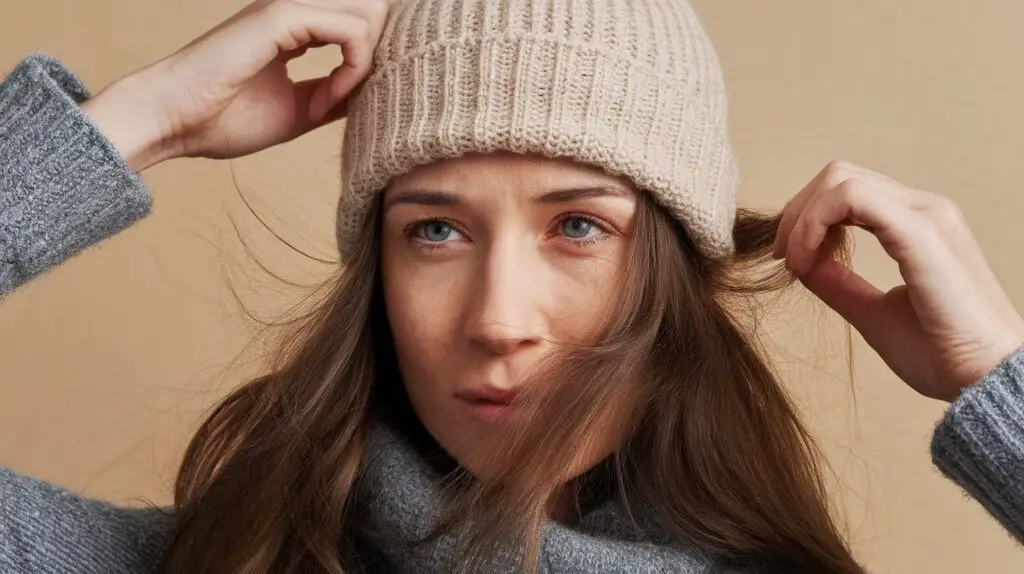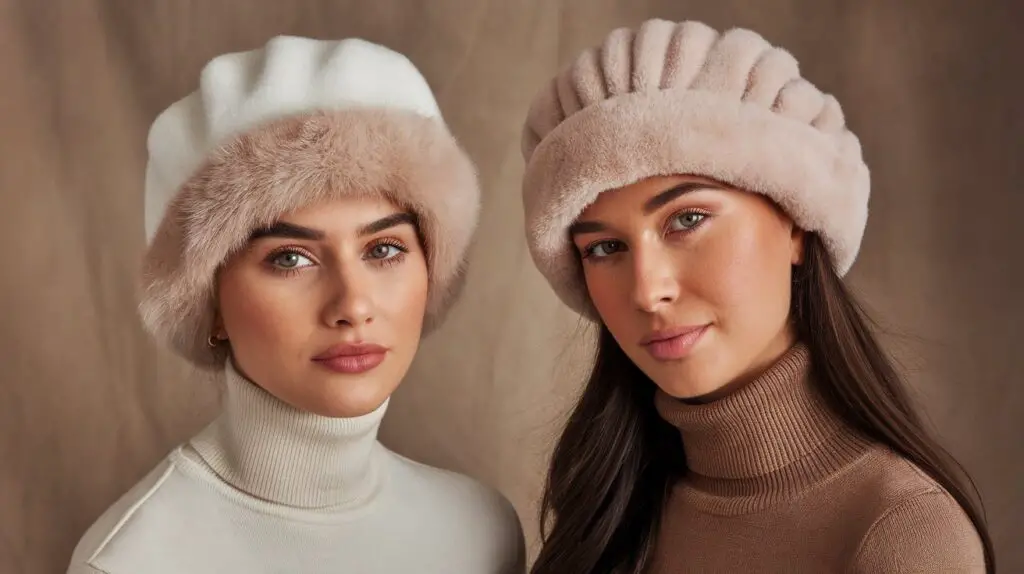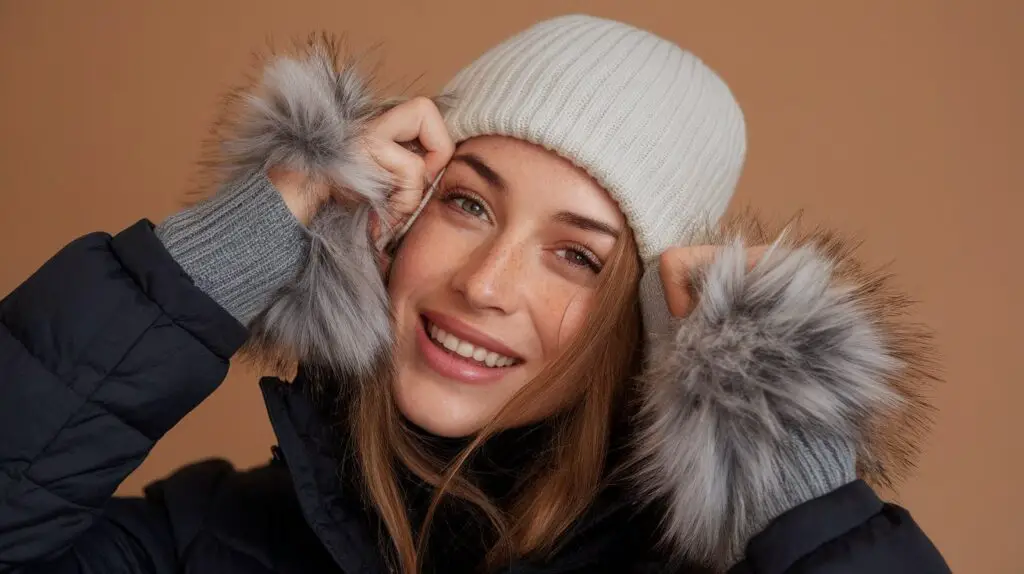Winter hats serve as essential accessories during cold months, yet many women struggle with the effects these hats have on their hair. The constant friction, pressure, and static electricity can lead to breakage, flatness, and overall hair damage – issues that affect both appearance and self-confidence.
Finding a balance between staying warm and maintaining healthy hair doesn’t require sacrificing style or comfort. The right techniques and proper hat selection can transform this daily challenge into a seamless part of your winter routine, while keeping your hair protected and looking its best throughout the season.
The following sections will share practical methods to wear winter hats without compromising your hair’s health. From choosing the right materials to mastering strategic styling techniques, you’ll discover how to maintain volume, prevent breakage, and boost your confidence while wearing winter hats. Read on to learn these simple yet effective approaches that combine both protection and style.
- What Makes Winter Hats Damaging to Your Hair?
- Which Hat Materials Are Best for Hair Protection?
- How Should You Style Your Hair Under Winter Hats?
- Smart Ways to Prevent Lifeless Hair
- What Are This Year's Most Hair-Friendly Winter Hat Styles?
- Your Winter Hat Style Guide for Healthy Hair
- Frequently Asked Questions
What Makes Winter Hats Damaging to Your Hair?

Your winter hat might be causing more hair damage than you realize. The constant contact between your hair and hat creates several issues that can affect both your hair’s health and appearance.
The effects of friction on hair strands
The repeated movement between your hair and hat creates friction that gradually weakens hair strands. This mechanical stress strips away the protective outer layer of your hair, leading to split ends and breakage. Think of your hair’s outer layer like shingles on a roof – constant rubbing eventually wears them down.
The damage becomes more noticeable in specific areas where your hat touches your hair most frequently. Here are the main ways friction affects your hair:
- Cuticle damage along the crown
- Roughened hair surface
- Increased tangles and knots
- Broken strands near the hairline
- Split ends around the nape
How winter hat materials affect moisture levels
Different hat materials interact with your hair’s natural moisture in various ways. Synthetic fabrics often create a barrier that traps heat and sweat against your scalp, disrupting your hair’s moisture balance. This can leave your hair either too dry or too oily, depending on your natural hair type.
Cotton hats, while comfortable, act like tiny sponges that absorb moisture from your hair. This absorption process can leave your strands dehydrated and prone to breakage, especially during colder months when your hair needs extra moisture.
Understanding static electricity and hair
Static electricity builds up as your hair rubs against your hat’s material. This creates an electrical charge that makes individual strands repel each other, resulting in flyaways and frizz. The problem becomes worse in dry winter air, as lack of moisture in the atmosphere increases static buildup.
Your hair type affects how much static you experience. Fine hair tends to show more static effects, while coarser hair types might experience less noticeable static but more tangling issues.
The pressure points that cause flatness
The weight of your hat creates pressure points where it sits most heavily on your head. These areas typically include the crown and the sides of your head, where hair becomes compressed and loses volume. This pressure effect can last for hours after removing your hat.
The temperature difference between your head and the cold air outside can make this flatness more persistent. Heat from your scalp combined with hat pressure can temporarily alter your hair’s natural shape and texture.
Common hair breakage patterns from hats
Hair breakage from hats follows specific patterns based on how you wear them. The hairline often shows the first signs of damage, with small broken hairs appearing around the forehead and temples. The crown area may develop a ring of breakage where the hat’s band sits.
The nape of your neck represents another vulnerable spot for breakage. As you move your head, the hat’s edge can repeatedly catch and break the fine hairs in this area. This creates a distinct pattern of shorter, broken strands that can take months to grow out.
The combination of these factors creates a cycle of damage that becomes more pronounced with daily hat wear. However, understanding these mechanisms helps you take steps to protect your hair while staying warm during winter months.
Which Hat Materials Are Best for Hair Protection?

Selecting the right material for your winter hat can make a significant difference in maintaining healthy hair during cold months. The fabric that touches your hair directly affects its moisture, strength, and overall appearance.
The benefits of satin-lined winter hats
Satin-lined hats provide superior protection for your hair by minimizing friction and preventing moisture loss. The smooth surface allows hair strands to glide freely, reducing tangles and breakage that commonly occur with traditional hat materials.
Your hair maintains its natural oils better with satin linings, which is particularly beneficial for curly and textured hair types. Here are the key advantages of choosing satin-lined options:
- Reduces split ends and breakage
- Preserves hairstyles throughout the day
- Prevents static electricity buildup
- Maintains hair’s natural moisture balance
- Minimizes frizz and flyaways
Cotton vs synthetic materials
Cotton hats might feel soft, but they can actually draw moisture away from your hair, leading to dryness and potential damage. Synthetic materials offer better moisture retention, though their effectiveness varies based on the specific fabric blend.
The choice between cotton and synthetic materials often depends on your hair type and daily activities. Synthetic fabrics typically provide better temperature regulation and maintain their shape longer than pure cotton options.
Why cashmere works well for hair
Cashmere stands out as a premium option for hair protection. This natural fiber contains amino acids that can actually benefit your hair’s health while providing exceptional softness. The material’s natural properties allow it to regulate temperature effectively without creating excess friction.
The microscopic structure of cashmere creates tiny air pockets that help maintain consistent temperature and humidity levels around your hair. This natural temperature regulation helps prevent the dry-wet cycles that often lead to hair damage.
The role of breathable fabrics
Breathable materials play a crucial role in preventing scalp sweating and subsequent hair problems. Good airflow helps maintain a healthy scalp environment and prevents the buildup of excess moisture that can lead to bacterial growth.
Different weave patterns affect breathability levels. A looser weave allows more air circulation but might provide less warmth, while tighter weaves offer more protection but less ventilation. Finding the right balance depends on your local climate and activity level.
Moisture-wicking properties to look for
The best winter hats combine moisture control with hair protection. Modern moisture-wicking materials move sweat and excess moisture away from your scalp while maintaining adequate hydration levels in your hair.
Look for materials with dual-action properties that can both repel external moisture and manage internal humidity. This combination helps create an optimal environment for your hair, preventing both excessive dryness and unwanted moisture accumulation.
Your winter hat should work as a protective barrier between your hair and harsh weather conditions. The right material choice helps maintain hair health while providing the warmth and comfort needed during cold weather.
How Should You Style Your Hair Under Winter Hats?

Preventing flat, lifeless hair after wearing a winter hat starts with the right preparation and techniques. A few simple steps can help maintain your style throughout the day, regardless of how long you wear your headwear.
Pre-hat styling preparations
Starting with the right foundation makes a significant difference in how your hair looks after removing your hat. These preparation steps create a protective base for your style:
- Apply a lightweight mousse to damp roots
- Blow-dry hair in the opposite direction of growth
- Set your style with cool air
- Use flexible-hold hairspray sparingly
- Create volume at the crown with gentle teasing
The key to successful preparation lies in building structure without stiffness. Your hair needs flexibility to bounce back after hat removal.
Essential moisture-locking products
Dry hair shows hat damage more prominently than well-hydrated strands. A leave-in conditioner creates a protective barrier between your hair and hat fabric, while maintaining necessary moisture levels throughout the day.
Natural oils like argan or jojoba can be applied to the mid-lengths and ends of your hair. These products seal the cuticle and prevent moisture loss without making your hair greasy or weighed down.
Silicone-free serums work particularly well for fine hair types, offering protection without excess weight. Apply these products sparingly, focusing on areas that experience the most friction from your hat.
Volume-maintaining techniques
Creating lasting volume requires strategic product placement and styling methods. Start by lifting sections of hair at the root and applying a root-lifting spray. This creates a foundation that resists flattening under pressure.
Try rolling the crown section of your hair with a large velcro roller while you finish getting ready. Remove the roller just before putting on your hat – this creates extra lift that helps maintain volume even under pressure.
Static control strategies
Static electricity can turn a good hair day into a mess of flyaways. A metal comb can help discharge static buildup before it becomes problematic. Run it through your hair before putting on your hat and after removing it.
Keeping a dryer sheet in your bag provides a quick solution for static emergencies. Gently run it over your hair to eliminate unwanted electricity. This method works especially well for fine or straight hair types.
Quick fix solutions for hat removal
Sometimes you need rapid solutions after taking off your hat. A dry shampoo can instantly revive flattened roots and absorb any excess oil that may have accumulated. Spray it directly at the roots, wait 30 seconds, then massage gently with your fingertips.
For immediate volume restoration, flip your head upside down and shake your fingers through your roots. This simple movement helps redistribute your hair’s natural oils and restores movement to flattened sections.
Using these techniques consistently helps train your hair to maintain its shape better under winter headwear. The right combination of products and methods can significantly reduce the appearance of hat-related styling issues.
Your hair type determines which methods work best. Fine hair might need more volume-building techniques, while thick hair often requires additional moisture-locking strategies to prevent frizz and static.
Smart Ways to Prevent Lifeless Hair

Preventing flat, lifeless hair after wearing a winter hat starts with the right preparation and techniques. A few simple steps can help maintain your style throughout the day, regardless of how long you wear your headwear.
Pre-hat styling preparations
Starting with the right foundation makes a significant difference in how your hair looks after removing your hat. These preparation steps create a protective base for your style:
- Apply a lightweight mousse to damp roots
- Blow-dry hair in the opposite direction of growth
- Set your style with cool air
- Use flexible-hold hairspray sparingly
- Create volume at the crown with gentle teasing
The key to successful preparation lies in building structure without stiffness. Your hair needs flexibility to bounce back after hat removal.
Essential moisture-locking products
Dry hair shows hat damage more prominently than well-hydrated strands. A leave-in conditioner creates a protective barrier between your hair and hat fabric, while maintaining necessary moisture levels throughout the day.
Natural oils like argan or jojoba can be applied to the mid-lengths and ends of your hair. These products seal the cuticle and prevent moisture loss without making your hair greasy or weighed down.
Silicone-free serums work particularly well for fine hair types, offering protection without excess weight. Apply these products sparingly, focusing on areas that experience the most friction from your hat.
Volume-maintaining techniques
Creating lasting volume requires strategic product placement and styling methods. Start by lifting sections of hair at the root and applying a root-lifting spray. This creates a foundation that resists flattening under pressure.
Try rolling the crown section of your hair with a large velcro roller while you finish getting ready. Remove the roller just before putting on your hat – this creates extra lift that helps maintain volume even under pressure.
Static control strategies
Static electricity can turn a good hair day into a mess of flyaways. A metal comb can help discharge static buildup before it becomes problematic. Run it through your hair before putting on your hat and after removing it.
Keeping a dryer sheet in your bag provides a quick solution for static emergencies. Gently run it over your hair to eliminate unwanted electricity. This method works especially well for fine or straight hair types.
Quick fix solutions for hat removal
Sometimes you need rapid solutions after taking off your hat. A dry shampoo can instantly revive flattened roots and absorb any excess oil that may have accumulated. Spray it directly at the roots, wait 30 seconds, then massage gently with your fingertips.
For immediate volume restoration, flip your head upside down and shake your fingers through your roots. This simple movement helps redistribute your hair’s natural oils and restores movement to flattened sections.
Using these techniques consistently helps train your hair to maintain its shape better under winter headwear. The right combination of products and methods can significantly reduce the appearance of hat-related styling issues.
Your hair type determines which methods work best. Fine hair might need more volume-building techniques, while thick hair often requires additional moisture-locking strategies to prevent frizz and static.
What Are This Year’s Most Hair-Friendly Winter Hat Styles?

Satin-lined winter headwear has transformed how women protect their hair during cold weather. These innovative styles combine fashion with functionality, offering solutions for various hair types and styling preferences.
Loose-fitting beanie variations
The latest designs feature extra room at the crown and a gentle elastic band that won’t create pressure marks. Satin-lined beanies with adjustable slouch factors allow you to customize the fit based on your hairstyle. These key features make them ideal for protecting your hair:
- Double-layer construction for warmth
- Wide circumference for natural hair volume
- Stretchy ribbed edges that don’t compress
- Moisture-wicking outer layer
- Anti-static interior lining
Adjustable beret techniques
Modern berets incorporate hidden drawstrings and elastic bands that adapt to different hair volumes. The circular shape distributes pressure evenly across your head, while the adjustable features let you modify the fit throughout the day.
The angled positioning of a beret creates space for updos and fuller styles. Position it slightly forward or back to accommodate your specific style needs without causing friction or flattening.
Modern turban-style winter hats
These updated classics feature pre-wrapped designs that eliminate the need for complex tying techniques. The structured front provides coverage while maintaining volume at the crown.
The wrapped sections create natural air pockets that protect curls and waves. Many styles now include hidden satin panels specifically positioned where hair experiences the most friction.
Structured caps with hair space
New architectural designs incorporate raised sections at the crown and sides. This thoughtful construction creates designated spaces for different hair textures and volumes.
The structured build maintains its shape without putting pressure on your style. Strategic ventilation points prevent moisture buildup while maintaining warmth.
Convertible hat designs
Multi-functional styles feature removable sections to adapt to different hair needs. Some pieces transform from full coverage to open-crown designs, offering versatility for various styling options.
Detachable linings allow you to adjust the level of protection based on your hair’s needs that day. Many styles include removable bands that can be repositioned to accommodate different styling preferences.
The interior construction of these modern designs prioritizes hair health. Smooth seams, strategic pleating, and careful placement of elastic elements work together to minimize stress on your strands.
Your hair texture and preferred styling methods should guide your choice. Thicker hair benefits from designs with more crown space, while finer textures might prefer styles with more structure.
Your Winter Hat Style Guide for Healthy Hair
Protecting your hair during winter doesn’t mean sacrificing style or comfort. The combination of proper hat materials, strategic styling techniques, and modern designs creates multiple options for maintaining healthy hair throughout the cold season. By selecting satin-lined accessories and implementing protective styling methods, you can keep your hair strong and beautiful while staying warm.
Your winter hat can become a powerful ally in hair care rather than a source of frustration. Whether you choose a slouchy beanie, an adjustable beret, or a structured cap with built-in hair space, the key lies in preparation and technique. With these styling approaches and the latest hair-friendly winter hat designs, you can confidently wear your favorite cold-weather accessories while maintaining your hair’s health and appearance.
Frequently Asked Questions
Q: Which winter hat material is best for preventing hair damage?
A: Satin-lined hats provide the best protection, as they reduce friction, prevent moisture loss, and minimize static electricity.
Q: How can I prevent flat hair when wearing a winter hat?
A: Apply a root-lifting spray before wearing your hat, and use a large velcro roller at the crown area while getting ready, removing it just before putting on your hat.
Q: What’s the best way to position a winter hat without ruining my hairstyle?
A: Place the hat at your forehead first, then roll it back instead of pulling it straight down. This method reduces friction and helps maintain your style.
Q: How can I control static electricity when wearing winter hats?
A: Use a metal comb before and after wearing your hat, or keep a dryer sheet handy to run over your hair when static occurs.
Q: What’s the quickest way to restore volume after removing a winter hat?
A: Flip your head upside down and shake your fingers through the roots, then apply dry shampoo at the roots and massage gently.
Q: Should I apply hair products before wearing a winter hat?
A: Yes, apply leave-in conditioner and natural oils to mid-lengths and ends, but keep products light at the roots to prevent buildup.
Q: What type of winter hat works best for curly hair?
A: Modern turban-style hats with pre-wrapped designs and hidden satin panels work well for curly hair, as they create air pockets that protect curl patterns.
Q: How tight should a winter hat fit to protect hair?
A: Choose loose-fitting styles with gentle elastic bands that won’t create pressure marks. The hat should have extra room at the crown to maintain volume.

